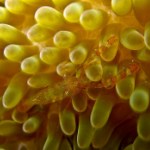sea
Image of a Gulf toadfish, Opsanus beta, from Wikimedia Commons
Teleost fish living in saltwater environments are constantly compensating for water loss. This happens because their surroundings have higher concentrations of salts than their plasma and the rule of thumb in Biology is: water follows salt. Thus these fish must somehow compensate for water loss in order to prevent dehydration. One way they do this is by drinking a lot of water. Ions are then removed from the water in the intestines which creates a gradient for water absorption into the body. A new…
Left Top: Pacific hatchetfish; Left Bottom: longfin lanternfish; Right: an acoustic instrument in the Pacific Ocean. (Images from Scripps Institution of Oceanography press release)
I love a good mystery. This one has puzzled scientists for several years now...ever since they discovered a humming or buzzing noise in the Pacific ocean, an otherwise rather quiet place. This was no ordinary noise, that they knew of. In a recent interview on NPR, Dr. Simone Baumann-Pickering, Scripps Institution of Oceanography (La Jolla, California) shared what she and her team think is causing all that noise…
Check out this neat video from National Geographic's emerging explorer, David Gruber (a marine biologist at the City University of New York) in which he discusses coming across what he claims is the first observation of biofluorescence in a sea turtle:
Video source:
YouTube
Few fish can survive the immense pressure of living in the deep sea. The Mariana Trench can reach around 36,200 feet deep with pressures of over 1,000 atmosphere. Scientists have placed landers at various depths ranging from 16,400-34,750 feet along the walls of the trench and have discovered what appears to be the "World's Deepest Fish". The fish was found at 26,872 feet which is estimated to be near the lower limit for bony fishes (of 27,600 feet). This newly discovered fish has what look like wings and tentacles. The video below was captured by the Hadal Ecosystem Studies expedition (HADES…
Ever wonder what lies beneath the polar ice? Turns out several researchers did as well. This past July a team of scientists led an expedition designed to image life under sea ice. The video below was captured with the Nereid Under Ice (NUI) vehicle and shows brown algae living on the bottom of sea ice as well as larvaceans, which are filter-feeding tunicates. The advantage of the new vehicle is that it can travel very far (the spools of cable are ~40 km long) and allows researchers to create maps and collect samples. Researchers are hoping to explore greater distances in future dives that…
With the help of advice from a manicurist, Dr. Kate Mansfeld (University of Central Florida) has come up with a way to track hatchling sea turtles for the first time. After hatching, the turtles head straight for the ocean where they grow for about 10 years or so before returning to the same beach where they hatched. Until now, researchers have wondered how these juvenile turtles spent their time.
Source:
Scientific American
In honor of the Discovery Channel's "Shark Week", check out these shark cams.
National Aquarium Reef Shark Cam:
Broadcast live streaming video on Ustream
SHARK FIN CAM: Video taken from a camera strapped to the dorsal fin of a shark:
Broadcast live streaming video on Ustream
If you have not yet tuned in to Discovery Channel, there are still a few days left of shark week!
Sounds kind of like an oxymoron doesn't it? Who knew sponges could be carnivorous? Scientists have described four new species of carnivorous sponges in a newly published article in Zootaxa. Check out this video from the lead author of the study, Lonny Lundsten who is a Senior Research Technician at the Monterey Bay Aquarium Research Institute:
Lundsten L, Reiswig HM, Austin WC. Four new species of Cladorhizidae (Porifera, Demospongiae, Poecilosclerida) from the Northeast Pacific. Zootaxa. 3786 (2): 101–123, 2014.
Amazon Prime Air might want to pay attention to this research. Scientists have studied the flight patterns of albatrosses to understand how the animals are able to sustain flight with minimal energy expenditure.
Caribbean sun anemone. Image from Wikimedia, Omar Spence Photography.
Dr. George Chandy at the University of California, Irvine discovered a toxin in Caribbean sun anemones (see photo) in 1984 and has spent his career studying the toxin. Prior work by his team suggested that a synthetic version of a peptide (ShK-186) from the toxin may help treat autoimmune disease. It works by blocking a specific potassium channel (Kv1.3) important in immune system reactivity. Since potassium channels are also important in the regulation of metabolism and body weight, his team wanted to explore…
On January 15, 1961, the US coastguard raced through the darkness toward a tiny point 84 miles southeast of New York City. There, 28 crew members of Texas Tower 4 were waiting desperately to be evacuated from their station. As huge swells and high winds pounded the hull of the ship, their radios picked up a frantic transmission from the tower: "We're breaking up". And with that, Texas Tower 4 and all of its occupants were pulled beneath the waves.
Built in 1957, the five Texas Towers were intended to become part of the USA's advanced early warning system against Soviet bombers. Named for…

